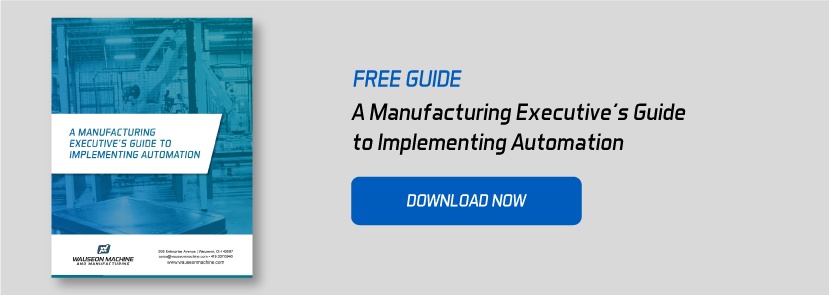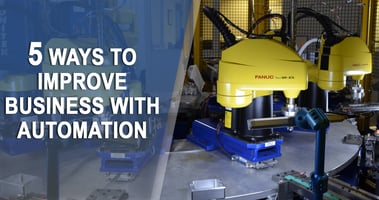(Image credit: https://phil.cdc.gov/Details.aspx?pid=23311) The outbreak of COVID-19 has launched...
Bottom-Line Benefits Manufacturing Executives Reap from Investing in Automation
.jpg?width=1684&name=Blog%20Post%2023%20-%20Mahan%20Approved%20(1).jpg)
Automation has been a staple in various factory settings for decades. And since the beginnings of industrial automation, there’s been a major shift in both technology and affordability.
But for some manufacturing executives, there remains a perception that the expense and risk of implementing automation is simply too much to be practical or worthwhile. The problem with this assumption is that it fails to acknowledge the immense profitability an investment in automation reaps for businesses of many types and sizes.
Over the last several decades, price points have dropped dramatically and capabilities have evolved incredibly. With the barrage of challenges and opportunities presented by modern issues like a worldwide pandemic, there’s expected to be even greater acceleration of companies integrating automation. Executives worldwide are taking advantage of the chance to reemerge from hardship with even greater technology and equipment potential.
In this post, we’re exploring why manufacturing executives are so focused on this aspect of their business and what they realistically stand to glean from adopting smart automation.
What the Research Says About Automation Potential
In a comparison of which industry sectors indicate the most potential for automation, recent research shows that manufacturing ranks number two (second only to accommodation and food services). In fact, a study of manufacturing work in 46 countries, covering about 80 percent of the global workforce, showed that of the 749 billion working hours spent on manufacturing-related activities, a whopping 64 percent were automatable with currently demonstrated technology. That amounts to a savings of $2.7 trillion in global labor costs.
Compounding this immense potential for automation is the increasing pressure placed on manufacturing executives to increase profitability for their organizations. Typically, that means adopting strategies to produce quality products both faster and at a reduced cost. It’s about keeping up with consumer demand, managing competitive pricing and producing P&L outcomes that reflect sustainable growth—all with a keen eye on safety and compliance.
This is the challenge facing modern manufacturing executives, and it’s a tall order in a changing industry landscape. But it’s also what makes the potential for automation so consequential. Manufacturing executives with a major focus on the business’s bottom line are realizing the positive, tangible impacts that can be gleaned from implementing automation solutions within their processes. There’s so much profitability opportunity to be explored by automating their manufacturing processes in ways that make the most sense for their business.
The Bread-and-Butter Benefits of Automation
To get the advantage of bottom-line savings and profitability, manufacturing executives need to adopt smart automation solutions that enable the company to perform better, faster, more inexpensively and with greater value to both consumers and investors. It’s essential to understand the real potential inherent in creating a path to automation that maximizes success for you and your organization.
The entire process begins with asking a fundamental question: What can automation actually do for the business? How this question is answered on a granular level depends on the specifics of your manufacturing business, but for the most part, it boils down to some vital competitive advantages:
- Reduced Operating Costs: Automation sets the business up for a decrease in operating expenses. This decrease is largely driven by a reduction in labor, but it could also be a product of a more consistent manufacturing process, which ultimately minimizes scrap. Obviously, the less waste there is, the lower your operating costs will be.
- Improved Throughput: Automation is known for improving the throughput of certain manufacturing processes. It’s about increasing the capacity utilization of your equipment. Automated solutions enable the processes to run through lunches, breaks, and shift changes, whereas human involvement necessitates equipment downtime for these occurrences. Combined with the advantage of decreased scrap, greater manufacturing availability generates greater throughput.
- Profitability Growth: Particularly for companies owned by private equity firms, there’s a major focus on sustainable growth. These firms are in the business of maximizing profitability, and one of the smartest ways to do that is by automating current processes. Executives who must report to a board on how they’re going to accomplish growth plans are familiar with what it takes to garner approval. As mentioned, automation allows for reduced operating costs and increased throughput, which inarguably increases profitability.
- Low-Risk ROI: When a growth plan involves designing a new product and going to market with it, there’s often a high risk of the sales volume underperforming the capital expenditure. Automation, on the other hand, is much more predictable, essentially lowering the risk of a launch that can't meet demand.
- Customization & Flexibility: Automation can be customized to the very specific needs of a manufacturing operation and designed to accommodate changes in product or process specifications down the road. This means there are no cookie-cutter requirements for ROI. In fact, there’s a distinct opportunity to achieve profitable outcomes based on a unique design and build that accounts for the individual challenges and realities of your business.
The Way Forward for Forward-Thinking Executives
Let’s face it: Technology is quickly refashioning how manufacturing companies operate their entire businesses. Automation is fueling ongoing advancement and profitability, from efficiency and accuracy to more streamlined operations and greater cost savings.
If you achieve a truly successful automation integration by making informed decisions based on strategy and professional guidance, you’re poised to maximize productivity and minimize waste. Profitable outcomes like faster production capabilities and decreased workforce expenses absolutely impact cost savings over the long term—a result that any manufacturing executive would be eager to realize in today’s economy.




